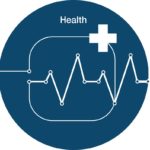 Health
Health
InSecTT project will strengthen the health domain in Europe by developing innovations for the healthcare of the future, which requires behaviour and health monitoring, diagnosis and treatment of people anywhere and anytime (home, travel, hospital etc.), thereby introducing new technologies/processes/tools to European healthcare industry and developing new innovations meeting the needs of European and global markets.
The overall market for telehealth is projected to reach $9.35 billion by 2021 from $2.78 billion in 2016, at a CAGR of 27.5% in the next five years (2016 to 2021). The growth of the industry can be attributed to growth in geriatric population, dearth of healthcare professionals worldwide, improvements in telecommunication infrastructure, technological advancements, increasing utilization of connected devices for the management of chronic diseases, and need for affordable treatment options due to rising healthcare costs.
The global telehealth market is forecasted to grow at a CAGR of 14.5% and will reach USD 25.3 Bn in 2022 from USD 14.8 Bn in 2018. The higher incidence of chronic diseases drives the growth of the telehealth market. The other key drivers include rising healthcare costs, and advancements in information and communication technology. The telehealth market is segmented based on technologies like remote patient monitoring (RPM), mHealth, and video telemedicine. The market is also segmented based on application such as teledermatology, teleradiology, telecardiology, telepathology, and others. The integration of Electronic Health Records (EHR), and systematized data collection of patients, along with upgraded software applications, are shaping the market.
Telehealth is a mode of providing healthcare services to the patient by using communication technology which further promote the diagnosis, consultation and providing better healthcare facilities to the patient. Telehealth also bridges the gap between patient and healthcare professional and improve satisfaction of patient. Telehealth offer various benefits over the conventional method such as it provides improved access of the distant patient condition, cost effective and better management of chronic disorder such as cancer, cardiovascular disorders and others. Telehealth and remote patient monitoring will prevent the waste of precious time of medical experts by 30%. Also, integration of various telehealth solutions by enabling smart AI connectivity and computational framework will reduce the cost of medical materials by 40% spent per patient in their health monitoring.
The proposed work in the project will contribute to strengthening the industrial competitiveness, growth and sustainability of companies by driving and validating AI based open connectivity and edge computing standards through the creation of advanced telehealth solutions based on these standards, leading to an eco-system for telehealth solutions that many companies can use and contribute to. This ecosystem will create a demand of domain specific expertise, i.e. AI optimized connectivity for health domain in Europe. Numerous interdisciplinary jobs will be created intersecting technology, medicine and business. Control stations that can remotely support operation theatres, intensive care units will be enabled using the technologies created from InSecTT. This will create around 30 new job per control centre per large hospital, amounting to 120,000 health-tech jobs all over Europe. Innovation capacity and the integration of new knowledge will be created through the telehealth eco system and cooperation with world-renowned European academic institutions and high-tech companies. In addition, InSecTT will contribute to the economic value in Europe by collaborating with healthcare institutions, high tech wireless solutions and telecom companies, forward looking network operators and wireless communication chips/modules manufacturers; and end users will involve on one hand clinical professionals in clinical centres and on the other hand people using smart medical devices. Hospitals, who are the collective end-users of health domain will be improvised to accommodate 10 times more patients with high quality healthcare. AI based optimization and prediction of health condition will also introduce new insurance models, which will be personalized per patient and cost efficient. Personalization using AI based connected medical device and remote patient monitoring will reduce the cost of health care 30% per year, while delivering the highest quality care.


